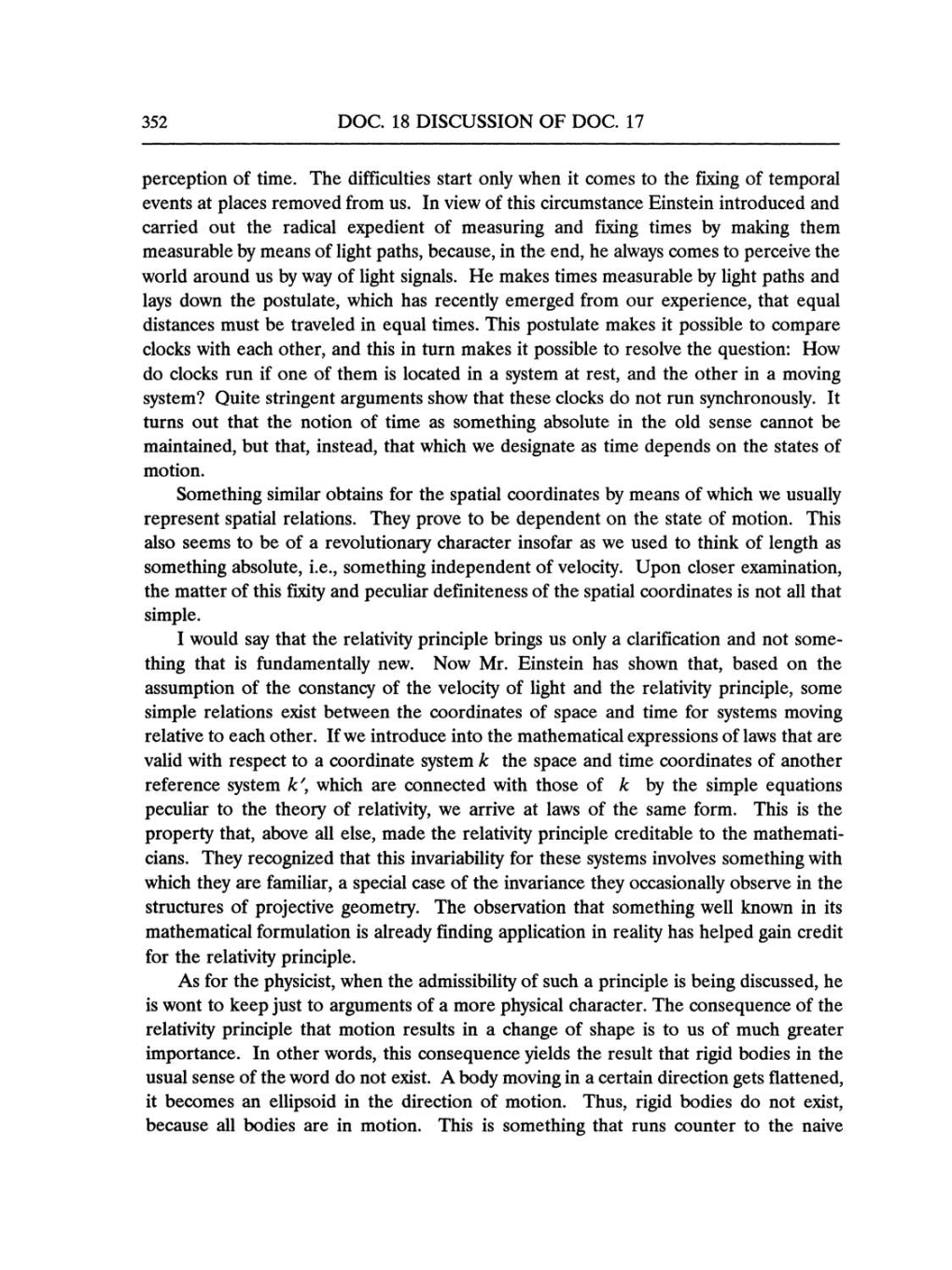352
DOC.
18
DISCUSSION OF
DOC.
17
perception
of
time.
The
difficulties start
only
when it
comes
to the
fixing
of
temporal
events at
places
removed
from
us.
In
view
of
this
circumstance
Einstein introduced
and
carried
out
the
radical
expedient
of
measuring
and
fixing
times
by making
them
measurable
by means
of
light paths,
because,
in
the
end,
he
always comes
to
perceive
the
world around
us by way
of
light signals.
He
makes times
measurable
by light
paths
and
lays
down
the
postulate,
which has
recently emerged
from
our
experience,
that
equal
distances must
be traveled
in
equal
times. This
postulate
makes it
possible
to
compare
clocks with
each
other,
and
this in turn makes it
possible
to resolve
the
question:
How
do clocks
run
if
one
of them
is
located
in
a system
at
rest,
and
the other
in
a
moving
system?
Quite
stringent arguments
show
that these
clocks do
not
run
synchronously.
It
turns out
that the notion of
time
as something
absolute
in
the
old
sense
cannot
be
maintained,
but
that,
instead,
that
which
we
designate
as
time
depends
on
the
states
of
motion.
Something
similar
obtains for the
spatial
coordinates
by
means
of
which
we
usually
represent
spatial
relations.
They
prove
to
be
dependent on
the
state
of motion.
This
also
seems
to
be of
a
revolutionary
character insofar
as we
used
to
think of
length
as
something absolute,
i.e.,
something independent
of
velocity.
Upon
closer
examination,
the
matter
of
this
fixity
and
peculiar
definiteness of the
spatial
coordinates
is not
all
that
simple.
I would
say
that the
relativity
principle
brings us only a
clarification and not
some-
thing
that
is
fundamentally new.
Now Mr.
Einstein
has shown
that,
based
on
the
assumption
of the
constancy
of the
velocity
of
light
and
the
relativity principle,
some
simple
relations
exist
between the coordinates of
space
and
time
for
systems moving
relative to
each other. If
we
introduce into the mathematical
expressions
of
laws
that
are
valid with
respect
to
a
coordinate
system
k the
space
and time coordinates of
another
reference
system
k', which
are
connected
with
those of
k
by
the
simple
equations
peculiar
to
the
theory
of
relativity, we
arrive at laws
of the
same
form. This
is
the
property
that, above all
else,
made the
relativity
principle
creditable
to
the mathemati-
cians.
They recognized
that
this
invariability
for these
systems
involves
something
with
which
they
are
familiar,
a
special case
of the
invariance
they
occasionally
observe in
the
structures
of
projective
geometry.
The observation that
something
well known in its
mathematical formulation
is already
finding
application
in
reality
has
helped
gain
credit
for the
relativity
principle.
As for the
physicist,
when the
admissibility
of
such
a principle
is
being discussed,
he
is
wont to
keep just
to
arguments
of
a more
physical
character. The
consequence
of the
relativity
principle
that motion results
in
a change
of
shape is
to
us
of much
greater
importance.
In other
words,
this
consequence
yields
the result that
rigid
bodies
in the
usual
sense
of
the word
do
not exist.
A
body
moving
in
a
certain direction
gets
flattened,
it
becomes
an ellipsoid
in
the direction of motion.
Thus, rigid
bodies do
not
exist,
because
all
bodies
are
in
motion.
This
is something
that
runs
counter to
the
naive
